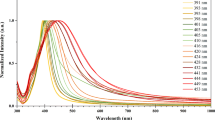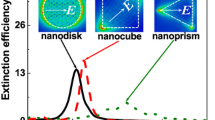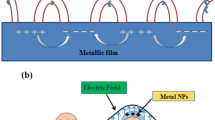Abstract
In this paper, we analyze the optical properties and sensitivities of spherical silver nanoparticles (AgNPs) with varying diameters (10–60 nm) in different surrounding medium, including water, ethanol, and chloroform. The investigation focuses on analytically assessing scattering efficiencies (\({{Q}_{{{\text{sca}}}}}\)), absorption efficiencies (\({{Q}_{{{\text{abs}}}}}\)), total extinction efficiencies (\({{Q}_{{{\text{ext}}}}}\)), shedding light on how the properties of AgNPs change with the size and surrounding medium of AgNPs. The results show that smaller AgNPs exhibit sharper plasmon resonance peaks at shorter wavelengths, while larger AgNPs display broader peaks in the visible spectrum, showcasing the size-dependent behavior of AgNPs. Additionally, the study calculates the molar attenuation coefficient (ε) and extinction cross section (\({{\sigma }_{{{\text{ext}}}}}\)) for AgNPs, highlighting the differences in absorption properties between small and large particles and their sensitivity to the surrounding medium. The research also discusses the implications of these properties for applications such as plasmonic sensing and sensor design, emphasizing the importance of particle size and surrounding medium in optimizing sensor performance. Moreover, the refractive index sensitivity (S) and the figure of merit (FOM) are introduced as critical parameters for assessing sensor performance, revealing their relationship with particle size, and providing valuable insights into sensor design and optimization.







Similar content being viewed by others
REFERENCES
Daniel, M.C. and Astruc, D., Gold nanoparticles: Assembly, supramolecular chemistry, quantum-size-related properties, and applications toward biology, catalysis, and nanotechnology, Chem. Rev., 2004, vol. 104, no. 1, pp. 293–346. https://doi.org/10.1021/cr030698+
Cheng, M.M.C., Cuda, G., Bunimovich, Y.L., et al., Nanotechnologies for biomolecular detection and medical diagnostics, Curr. Opin. Chem. Biol., 2006, vol. 10, no. 1, pp. 11–19. https://doi.org/10.1016/j.cbpa.2006.01.006
Haes, A.J. and Van Duyne, R.P., A nanoscale optical biosensor: Sensitivity and selectivity of an approach based on the localized surface plasmon resonance spectroscopy of triangular silver nanoparticles, J. Am. Chem. Soc., 2002, vol. 124, no. 35, pp. 10596–10604. https://doi.org/10.1021/ja020393x
Paramelle, D., Sadovoy, A., Gorelik, S., et al., A rapid method to estimate the concentration of citrate capped silver nanoparticles from UV-visible light spectra, Analyst, 2014, vol. 139 no. 19, pp. 4855–4861. https://doi.org/10.1039/C4AN00978A
Majeed Khan, M.A., Kumar, S., Ahamed, M., et al., Structural and thermal studies of silver nanoparticles and electrical transport study of their thin films, Nanoscale Res. Lett., 2011, vol. 6, p. 434.https://doi.org/10.1186/1556-276X-6-434
Dement’eva, O.V. and Kartseva, M.E., Noble metal nanoparticles in biomedical thermoplasmonics, Colloid J., 2023, no. 4, pp. 500–519. https://doi.org/10.1134/S1061933X23700187
Mirkin, C.A., Letsinger, R.L., Mucic, R.C., and Storhoff, J.J., A DNA-based method for rationally assembling nanoparticles into macroscopic materials, in Spherical Nucleic Acids, Jenny Stanford Publishing, 2020, pp. 3–11. https://doi.org/10.1201/9780429200151
Mulfinger, L., Solomon, S.D., Bahadory, M., et al., Synthesis and study of silver nanoparticles, J. Chem. Educ., 2007, vol. 84, no. 22, p. 322. https://doi.org/10.1021/ed084p322
Evanoff, D.D. and Chumanov, G., Size-controlled synthesis of nanoparticles. Measurement of extinction, scattering, and absorption cross sections, J. Phys. Chem. B, 2004, vol. 108, no. 37, pp. 13957–13962. https://doi.org/10.1021/jp047565s
Islam, M.A., Jacob, M.V., and Antunes, E., A critical review on silver nanoparticles: From synthesis and applications to its mitigation through low-cost adsorption by biochar, J. Environ. Manage., 2021, vol. 281, p. 111918. https://doi.org/10.1016/j.jenvman.2020.111918
Shafaghat, A., Synthesis and characterization of silver nanoparticles by phytosynthesis method and their biological activity, Synth. React. Inorg., Met.-Org., Nano-Met. Chem., 2015, vol. 45, no. 3, pp. 381–387. https://doi.org/10.1080/15533174.2013.819900
Aguilar-Méndez, M.A., San Martín-Martínez, E., Ortega-Arroyo, L., et al., Synthesis and characterization of silver nanoparticles: Effect on phytopathogen Colletotrichum gloesporioides, J. Nanopart. Res., 2011, vol. 13, pp. 2525–2532. https://doi.org/10.1007/s11051-010-0145-6
Anandalakshmi, K., Venugobal, J., and Ramasamy, V.J.A.N., Characterization of silver nanoparticles by green synthesis method using Pedalium murex leaf extract and their antibacterial activity, Appl. Nanosci., 2016, vol. 6, pp. 399–408. https://doi.org/10.1007/s13204-015-0449-z
Mie, G., Beiträge zur Optik trüber Medien, speziell kolloidaler Metallösungen, Ann. Phys., 1908, vol. 330, no. 3, pp. 377–445. https://doi.org/10.1002/andp.19083300302
Kreibig, U. and Vollmer, M., Optical Properties of Metal Clusters, Springer Science & Business Media, 2013, vol. 25. https://doi.org/10.1007/978-3-662-09109-8
Papavassiliou, G.C., Optical properties of small inorganic and organic metal particles, Prog. Solid State Chem., 1979, vol. 12, nos. 3–4, pp. 185–271. https://doi.org/10.1016/0079-6786(79)90001-3
Alrahili, M., Savchuk, V., McNear, K., and Pinchuk, A., Absorption cross section of gold nanoparticles based on NIR laser heating and thermodynamic calculations, Sci. Rep., 2020, vol. 10, no. 1, p. 18790. https://doi.org/10.1038/s41598-020-75895-9
The Mie Theory: Basics and Applications, Hergert, W. and Wriedt, T., Eds., Springer, 2012, vol. 169. https://doi.org/10.1007/978-3-642-28738-1
Tang, J., Gao, K., Ou, Q., et al., Calculation extinction cross sections and molar attenuation coefficient of small gold nanoparticles and experimental observation of their UV–vis spectral properties, Spectrochim. Acta, Part A, 2018, vol. 191, pp. 513–520. https://doi.org/10.1016/j.saa.2017.10.047
Shang, J. and Gao, X., Nanoparticle counting: Towards accurate determination of the molar concentration, Chem. Soc. Rev., 2014, vol. 43, no. 21, pp. 7267–7278. https://doi.org/10.1039/C4CS00128A
Alrahili, M., Peroor, R., Savchuk, V., et al., Morphology dependence in photothermal heating of gold nanomaterials with near-infrared laser, J. Phys. Chem. C, 2020, vol. 124, no. 8, pp. 4755–4763. https://doi.org/10.1021/jp409067h
Tiwari, P.M., Vig, K., Dennis, V.A., and Singh, S.R., Functionalized gold nanoparticles and their biomedical applications, Nanomaterials, 2011, vol. 1, no. 1, pp. 31–63. https://doi.org/10.3390/nano1010031
Lee, K.S. and El-Sayed, M.A., Gold and silver nanoparticles in sensing and imaging: Sensitivity of plasmon response to size, shape, and metal composition, J. Phys. Chem. B, 2006, vol. 110, no. 39, pp. 19220–19225. https://doi.org/10.1021/jp062536y
Lerner, M.I., Bakina, O.V., Kazantsev, S.O., Glazkova, E.A., and Svarovskaya, N.V., Silver-Containing bicomponent nanoparticles: Relationship between morphology and electrokinetic potential, Colloid J., 2023, vol. 85, no. 4, pp. 520–530. https://doi.org/10.1134/S1061933X23600422
Singh Sekhon, J. and S Verma, S., Refractive index sensitivity analysis of Ag, Au, and Cu nanoparticles, Plasmonics, 2011, vol. 6, pp. 311–317. https://doi.org/10.1007/s11468-011-9206-7
Sekhon, J.S. and Verma, S.S., Optimal dimensions of gold nanorod for plasmonic nanosensors, Plasmonics, 2011, vol. 6, pp. 163–169. https://doi.org/10.1007/s11468-010-9182-3
Cobley, C.M., Skrabalak, S.E., Campbell, D.J., and Xia, Y., Shape-controlled synthesis of silver nanoparticles for plasmonic and sensing applications, Plasmonics, 2009, vol. 4, pp. 171–179. https://doi.org/10.1007/s11468-009-9088-0
Dave, J.V., Scattering of electromagnetic radiation by a large, absorbing sphere, IBM J. Res. Dev., 1969, vol. 13, no. 3, pp. 302–313. https://doi.org/10.1147/rd.133.0302
Bohren, C.F. and Huffman, D.R., Absorption and Scattering of Light by Small Particles, John Wiley & Sons, 2008. https://doi.org/10.1147/rd.133.0302
Hulst, H.C. and van de Hulst, H.C., Light Scattering by Small Particles, Courier Corporation, 1981.
Evanoff Jr, D.D. and Chumanov, G., Synthesis and optical properties of silver nanoparticles and arrays, ChemPhysChem, 2005, vol. 6, no. 7, pp. 1221–1231. https://doi.org/10.1002/cphc.200500113
Haiss, W., Thanh, N.T., Aveyard, J., and Fernig, D.G., Determination of size and concentration of gold nanoparticles from UV−Vis spectra, Anal. Chem., 2007, vol. 79, no. 11, pp. 4215–4221. https://doi.org/10.1021/ac0702084
Palik, E.D., Handbook of Optical Constants of Solids, Academic Press, Inc., New York, 1985.
Laven, P., MiePlot (A computer program for scattering of light from a sphere using Mie theory & the Debye series), 2011. http://www.philiplaven.com/mieplot.htm.
Ungut, A., Grehan, G., and Gouesbet, G., Comparisons between geometrical optics and Lorenz−Mie theory, Appl. Opt., 1981, vol. 20, no. 17, pp. 2911–2918. https://doi.org/10.1364/ao.20.002911
Acharya, D., Mohanta, B., Deb, S., and Sen, A.K., Theoretical prediction of absorbance spectra considering the particle size distribution using Mie theory and their comparison with the experimental UV–Vis spectra of synthesized nanoparticles, Spectrosc. Lett., 2018, vol. 51, no, 3, pp. 139–143. https://doi.org/10.1080/00387010.2018.1442351
Chen, H., Kou, X., Yang, Z., et al., Shape-and size-dependent refractive index sensitivity of gold nanoparticles, Langmuir, 2008, vol. 24, no. 10, pp. 5233–5237. https://doi.org/10.1021/la800305j
Hill, C.M. and Pan, S., A dark-field scattering spectroelectrochemical technique for tracking the electrodeposition of single silver nanoparticles, J. Am. Chem. Soc., 2013, vol. 135, no. 46, pp. 17250–17253. https://doi.org/10.1021/ja4075387
Leopold, N. and Lendl, B., A new method for fast preparation of highly surface-enhanced Raman scattering (SERS) active silver colloids at room temperature by reduction of silver nitrate with hydroxylamine hydrochloride, J. Phys. Chem. B, 2003, vol. 107, no. 24, pp. 5723–5727. https://doi.org/10.1021/jp027460u
Austin, L.A., Mackey, M.A., Dreaden, E.C., and El-Sayed, M.A., The optical, photothermal, and facile surface chemical properties of gold and silver nanoparticles in biodiagnostics, therapy, and drug delivery, Arch. Toxicol., 2014, vol. 88, pp. 1391–1417. https://doi.org/10.1007/s00204-014-1245-3
Kneipp, K., Kneipp, H., and Kneipp, J., Surface-enhanced Raman scattering in local optical fields of silver and gold nanoaggregates from single-molecule Raman spectroscopy to ultrasensitive probing in live cells, Acc. Chem. Res., 2006, vol. 39, no. 7, pp. 443–450.https://doi.org/10.1021/ar050107x
Li, L., Yu, Z., Chang, C.H., et al., Efficient white polymer light-emitting diodes employing a silver nanowire–polymer composite electrode, Phys. Chem. Chem. Phys., 2012, vol. 14, no. 41, pp. 14249–14254. https://doi.org/10.1039/C2CP41562C
Chen, L.Q., Xiao, S.J., Peng, L., et al., Aptamer-based silver nanoparticles used for intracellular protein imaging and single nanoparticle spectral analysis, J. Phys. Chem. B, 2010, vol. 114, no. 10, pp. 3655–3659. https://doi.org/10.1021/jp9104618
Abo Riziq, A., Trainic, M., Erlick, C., et al., Extinction efficiencies of coated absorbing aerosols measured by cavity ring down aerosol spectrometry, Atmos. Chem. Phys., 2008, vol. 8, no. 6, pp. 1823–1833. https://doi.org/10.5194/acp-8-1823-2008
Ajitha, B., Reddy, Y.A.K., Reddy, P.S., et al., Role of capping agents in controlling silver nanoparticles size, antibacterial activity and potential application as optical hydrogen peroxide sensor, RSC Adv., 2016, vol. 6, no. 42, pp. 36171–36179. https://doi.org/10.1039/C6RA03766F
Funding
This work was supported by ongoing institutional funding. No additional grants to carry out or direct this particular research were obtained.
Author information
Authors and Affiliations
Corresponding author
Ethics declarations
As author of this work, I declare that I have no conflicts of interest.
Additional information
Publisher’s Note.
Pleiades Publishing remains neutral with regard to jurisdictional claims in published maps and institutional affiliations.
APPENDIX A
APPENDIX A
MODELING
Electromagnetic scattering by a homogeneous sphere was referred to as Mie scattering theory. The distribution by spherical NPs was solved exactly regardless of the size of the NPs as long as the resonance of NPs near the frequency of the incident wavelength by Gustava Mie [14]. According to the Mie scattering solution, scattering S1(θ) and extinction S2(θ) coefficients were expanded using spherical functions for a homogeneous plane wave [28–32].
Here S1(θ) and S2(θ) are related to scattering and extinction coefficients (Qsca & Qext), respectively. The functions \({{\tau }_{n}}\) and \({{\pi }_{n}}\) are related to the Legendre polynomials \({{P}_{n}}\) as follows:
The standard evaluation of these representations can be found elsewhere (2,3). \({{a}_{n}}\) and \({{b}_{n}}\) are the expressions of Mie coefficients. The assumptions were made that the refractive index of the nanoparticles is \({{n}_{p}}\), and the refractive index of the surrounding medium is \({{n}_{m}}\). Then the coefficients embedded in the refractive indexes are given by the following [27–29]:
The primes “'” indicated to the derivatives. \({{\psi }_{n}}\) and \(\zeta _{n}^{'}\left( x \right)\) are spherical functions known as Riccati–Bessel functions, which are related to the spherical Bessel functions \(z{{j}_{n}}\left( z \right)\) and \({{\zeta }_{n}}\left( z \right)\) as follows:
The argument z indicates that it is an arbitrary complex number, and the arguments x and y are used for Mie coefficients related to the particle size (x) and surrounding medium (y). They defined as follow:
Here, λ is the wavelength in vacuum, and r is the radius of the NPs. In the case of the surrounding medium is absorbed, \({{n}_{m}}\) has a real and imaginary part of the refracctive index. Therefore, x is a complex function. Consequencelly, the spherical functions (Riccati–Bessel functions) become unstable because these functions entered the exponential domain and passed out the limit of boundaries. The Eqs. (5A) and (6A) were rewritten to fit with these boundary conditions as follows:
The optical properties of spherical AgNPs were presented in terms of their calculated scattering, extinction, and scattering efficiencies by Mie scattering theory represented in the calculated method section for the homogenous sphere. The incident plane wavelength was set to be in the visible range at 390 nm, where most spherical AgNPs have LSPR around 390 nm. The required parameters for the calculations are the radius (r), the refractive index of the surrounding medium of the NPs, which is np = 1.33, 1.36, and 1.45 for water, ethanol, and chloroform, respectively, as well the refractive index of the vacuum, which is nm = 1. Equations (1A) and (2A) can be simplified as follow:
The efficiences described above can be translated to the corresponding cross sections by multiplying Qabs,sca,and ext with cross sectional areas (πr2) of spherical AgNPs. Hence, the corresponding cross section of absorption, scattering, and extinction can be written as follows:
In brief, the calculations pertaining to Qsca and Qext were executed with the aid of the user-friendly software known as MiePlot [34], which played a vital role in validating the precision of the computational results and ensuring their alignment with established findings. Furthermore, the results obtained from the MiePlot software underwent rigorous verification through the application of a modified version of the FORTRAN 77 code, as initially outlined in the research by Haiss et al. [32] and originally introduced by Bohr and Huffman [29]. Succinctly, this methodology encompassed the incorporation of silver dielectric data as outlined by Palik [33] and the meticulous selection of optical constants for the purpose of generating simulated extinction data. Essential parameters, including the plasma frequency (9.5 × 1014 Hz for silver), collision frequency (0.4 × 1014 Hz for silver), and Fermi velocity (1.4 × 108 for silver), were finely tuned within the code to faithfully represent the unique characteristics of silver.
Rights and permissions
About this article
Cite this article
Mazen Alrahili Single Silver Nanoparticles: Local Refractive Index Response to Localized Surface Plasmon Resonance and Molar Attenuation Coefficient. Colloid J 86, 138–152 (2024). https://doi.org/10.1134/S1061933X23600860
Received:
Revised:
Accepted:
Published:
Issue Date:
DOI: https://doi.org/10.1134/S1061933X23600860






